How to properly install the filter in the aquarium?
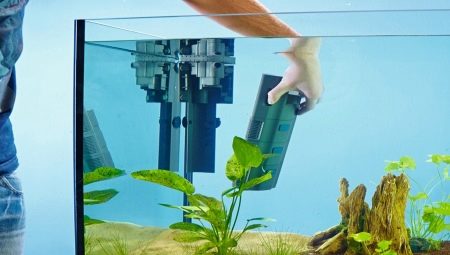
The aquarium filter is an indispensable element in any aquarium. It performs mechanical and biological purification, and also promotes oxygenation. The choice of filters in retail outlets is huge, so it will not be difficult to purchase a device. But with mounting, problems may appear. Installing an aquarium filter element is a real challenge for most inexperienced aquarists.
Alas, it is not always possible to navigate the intricacies by the annotation attached to the aggregate. The installation procedure will be different for internal and external (external) filter elements, but anyone can really handle the task.
Preparatory stage
The preparatory process includes several steps.
- First of all, you need to prepare dry rags, because not every time it is possible to eliminate the leakage of water.
- We release the device from the packaging and take out all the contents. Without fail, the complete set must include: the device itself, fillers, plastic water outlets, internal sponges, hoses.
- Before assembly, it is necessary to check that all components are perfectly dry. The assembly of the external (external) filter is carried out according to the manufacturer's instructions. Be sure to follow the established procedure. The taps on the lid must be in the closed position.
- Now you can start preparing the external elements so that you can release and take water. The element of the fence is a long tube, rounded at the end. One end of it must be lowered into the aquarium.The evacuation device is a curved short tube, which is installed at the other end of the aquarium. It is imperative to measure the size of the tubes so that they are long enough to reach the curbstone.
- Before installing the device, it is necessary to fill at least 50% of the aquarium with water, since the cleaning equipment is used only fully filled.

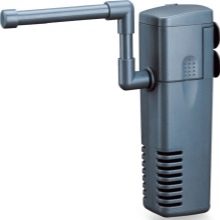
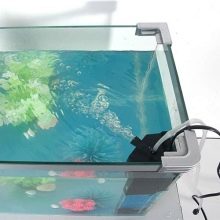
Where to locate?
Determining the correct location for the filter element depends on the characteristics of the aquarium, its size and configuration. As a rule, filtering devices are fixed to the side wall of the tank, near the rear window, so as not to interfere with the life of local inhabitants. If the filter element is internal, then there is a special mark on it, which means that it is forbidden to dive too deep so that it does not touch the bottom.
If the depth is shallow, then try to leave a large distance in the upper part, but under no circumstances should the device be at the bottom. The water will always evaporate, therefore the location of the filter must be constantly monitored.
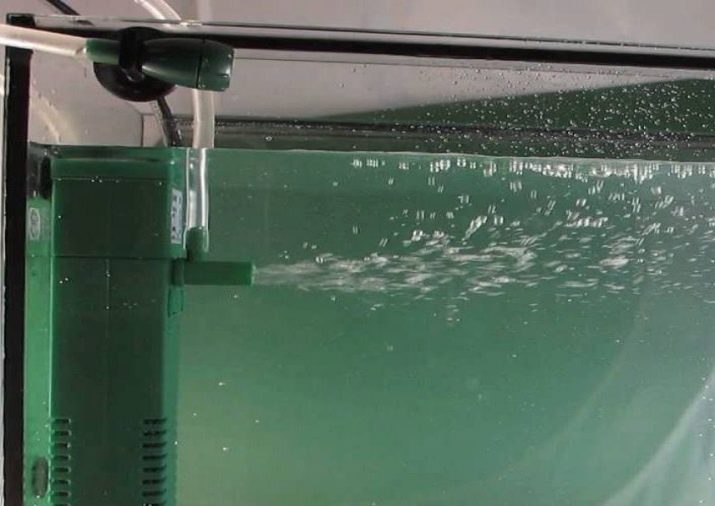
Installation of different models
The range of filters is very large, so it is necessary to learn all the nuances of installing various types of filters.
External
Installing the filter element in the aquarium is not a particularly difficult procedure; you just need to calculate where this equipment will be placed. As a rule, it is located in a cabinet under the aquarium, for this, holes are drilled in the back wall of the furniture, which are required for routing the hoses.
The filter will need to be assembled in strict accordance with the practical guide. All sponges and a specialized nutrient medium (substrate) for biochemical water purification are placed in the filter cavity. In the aquarium, pipes are placed at the inlet and outlet, which must be submerged. With the correct installation of the filter in the aquarium, the equipment should be located below the level of the bottom, which will make it possible to guarantee maximum pump performance.
The filter must be installed in its permanent place, then, by means of a manual mechanical pump, bleed the system, trying to remove air from the pipes and housing as much as possible. Only a few strokes of the mechanical pump are necessary, as a result of which the liquid medium will spontaneously move along the inlet tube, expelling air from the filter element. After the body is completely filled with water, air will stop coming out of the outlet tube.
Now you can connect the equipment to the mains and test its efficiency.
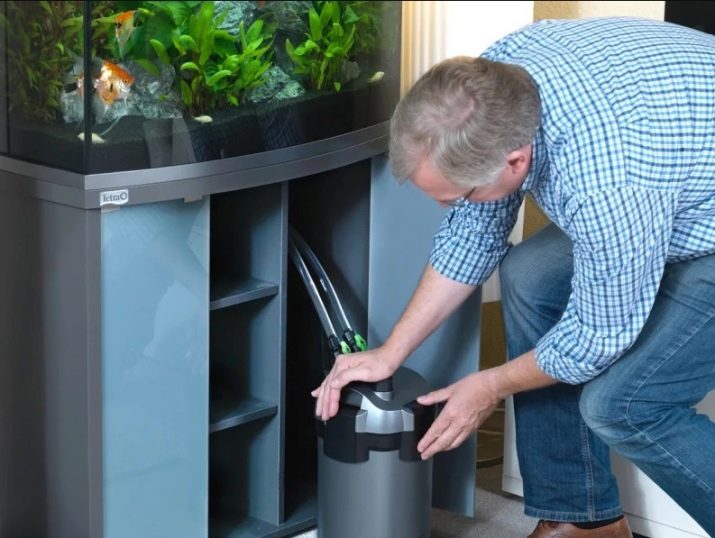
If the filter does not start or operates at low power, this indicates the presence of an air lock in the system, therefore, it will be necessary to remove air from the pipes and the housing. For this purpose, already on the operating filter, press the key of the mechanical pump several times, which makes it possible to squeeze out the air from the system.
A small amount of air may be trapped inside the case and begin to gurgle. In order to finally do away with such small bubbles, you must carefully pry the filter and bend it from side to side.
Having started to work at its full capacity, the device immediately activates the implementation of mechanical water purification. But biochemical filtration, when nitrates and nitrites are removed, starts approximately one month after the start of the equipment. During this period, colonies of chemosynthetic bacteria will settle on the nutrient medium used, which are responsible for the chemical purification of water.
Actually, for this reason, if possible, it is necessary to populate fish (exotic species are especially demanding) several weeks after the installation of the external filter in the aquarium is completed.

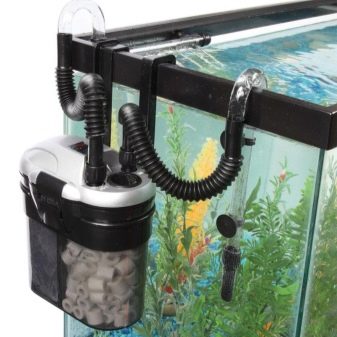
Interior
The installation of the internal filter element in the aquarium is simple.This fixture does not require the purchase of additional equipment or upgrades, and most of the models can be placed both vertically and horizontally. In this regard, regardless of modification, the filter is assembled in strict accordance with the manufacturer's instructions.
- Acquaintance with the device. Correct installation of any filter starts with revising its completeness and reading the practical manual. It is advisable to do this even before purchasing the device. If you are unsure of your own technical abilities, you should ask the sales assistant to personally show you the assembly procedure or to explain it in detail.
- Assembling the fixture. Basically, all internal filtering devices are assembled according to the same method. First of all, it is required to place the filter material in the "glass" of the apparatus. Then, if the structure provides it, insert the rotor into the pump. Fix the pump to the glass and connect the air exchange tube.
- With certain modifications, the mounting plate is isolated from the casing. Insert the “cup” clips into the recesses provided on it and position the suction cups in the proper slots. Everything is ready for mounting the filter in the aquarium.
- After the filter is ready for installation, you should not rush to place it in the aquarium.... First of all, all inhabitants are removed from it in a separate container. The operation is not necessary, but if the purchased device is endowed with factory defects, then when it is connected, the pets have every chance of suffering. Professional aquarists advise not to endanger the health of the fish, and place them for a while in a jig, and then install an internal filter in the aquarium.
- Fixation of the apparatus. Basically, all aquarium filters are fixed to the tank wall by means of suction cups. You just need to simply press them down to the glass surface and press hard. Submersible filter devices must be completely under the water surface - never turn on the filter if it looks out of the water. The ideal depth of the filter element is 2-5 centimeters from the surface. Standard internal samples have a transparent flexible air exchange tube. Its function is to supply air, because one end of the tube is connected to the device, and the other must be in an open space.
- First start. Switching on after the installation of the filter in the aquarium, in principle, implies working in test mode. Therefore, it is desirable to monitor the functioning of the filtering device. Correct the immersion depth.
- Power setting. During the first start or immediately after that, you need to turn the dimmer to medium parameters. Subsequent adjustments should be made taking into account the volume of the aquarium, the level of pollution and, of course, the habits of its inhabitants. Some fish, for example, with small and weak fins, cannot withstand extremely powerful currents.

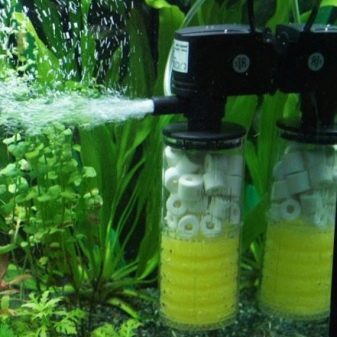
Donny
The bottom water filter should be placed at the bottom of the aquarium. This type is chosen by owners of large aquariums with a small volume of underwater flora. The device itself looks like a thin plate with a filter filler, and a large number of holes through which water passes.
A large number of aquarists believe that just sitting on the bottom is enough for the eyes. Nevertheless, the filter needs to be mounted, and not placed on the substrate.
Aquarium Bottom Unit - Installation Procedure:
- all soil is removed from the selected site at the bottom of the aquarium so that the base is 100% exposed;
- the bottom filter is carefully placed on the bottom;
- the device is covered over with soil so that the device does not spoil the look of the aquarium;
- start the device.
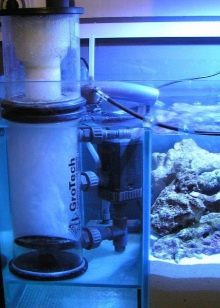
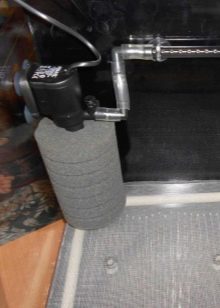

Biofilter
The device for biological cleaning of the aquarium works by special bacteria that absorb hydrogen nitride, which forms during the life of the inhabitants.
You can easily make a biofilter yourself. And we will consider the installation of a homemade model called "bottle". Its size depends on the volume of the aquarium.
To install such a device:
- make holes in the bottom of the bottle so that the water gets inside;
- wrap this place with elastic polyurethane foam (foam rubber);
- secure with plastic clamps to prevent unnecessary contamination of the gravel;
- pour about half of the filler into the bottle;
- lead the compressor aerator tube through the throat from above;
- thanks to the "airlift", water will be sucked out of the bottle, and fresh, untreated water will arrive through its bottom.
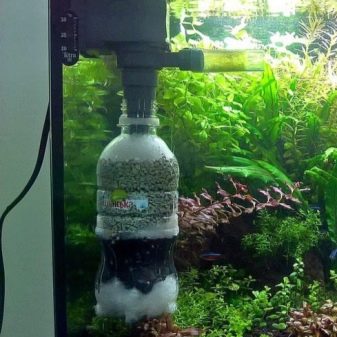
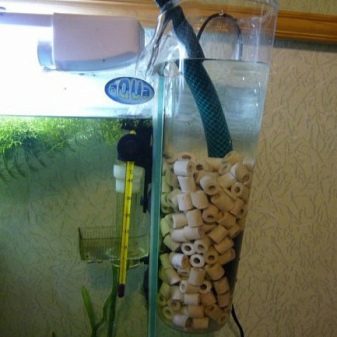
Phyto filter
Do not bundle the phyto filter with a biological purifier. The principle of the phyto filter is that vegetation does not grow in water, but on the surface. And only its roots are in the water, purifying it.
The simplest structure of a phyto filter is a tray with plants attached to the wall of the aquarium. Ordinary indoor vegetation is planted in a prepared nutrient medium in a tray with holes. The tray is then fixed to the wall of the aquarium and a stream of water from the aquarium passes through it.
Another variation of this attachment is the vegetation reservoir, which is integrated into the aquarium lid.
The essence is the same: the plant roots planted in a coarse-grained substrate are directly connected to the water in the aquarium and absorb harmful (but useful for themselves) compounds from it.
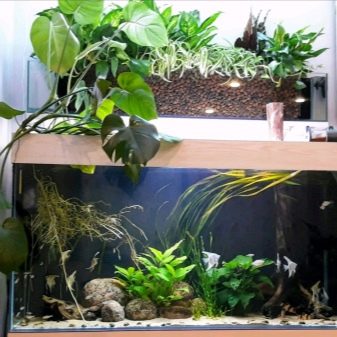

Care rules
The main thing that an aquarium filter requires is the constant cleaning of the filtering components from the dirt accumulated in them. The principle is this: the smaller the size of the filter elements and the higher the load on the device, the sooner it gets dirty and the more often it needs to be cleaned. Basically, cleaning the internal filter device in a typical aquarium is done about once a week.
External device cleaning - 1-2 times a month. The most accurate cyclicality is calculated in each version individually based on the characteristics of the entire aqua system as a whole.
In the process of cleaning a filter for an aquarium, only the filter filler needs constant maintenance, the device itself is relatively rarely cleaned, and devices of certain modifications, in particular, airlift ones, completely eliminate the need to clean the filter, not taking into account the filter filler.

The cleaning procedure must be carried out as quickly as possible, gently and exclusively in the water taken from the aquarium. Everything is very simple. The main value in the cleaning material is the colonies of microorganisms participating in the biological treatment process, and the main goal in cleaning the filter media is, on the one hand, to eliminate debris and dirt accumulated in the filler, and on the other, to minimize damage to the microorganism colony located in those places. The less damage is done to microorganisms, the sooner the filter resumes its biological purification capability.
And in conclusion, an extremely important recommendation that novice aquarists sometimes forget about - the filter must function non-stop. It can be turned off only during the period of cleaning and rinsing the cleaning elements.

For information on how to properly install the filter in the aquarium, see the next video.








